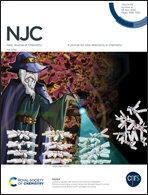Photoisomerizable azobenzene star-shaped liquid crystals: bypassing the absence of hydrogen bonding†‡
Abstract
Liquid crystals (LCs) containing an azo group are often used in the construction of molecular systems that present both mesomorphic features and reversible photoisomerization. The interest in the search for new materials of this type is related to a better understanding and improvement of their performance. Therefore, this work presents the synthesis and characterization of seven new organic azo compounds with a star-shaped disk-like molecular structure, of which three exhibited the properties of columnar LCs. The molecular structures vary in the rigid core size, the functional linker group (ester, amide or 1,3,4-oxadiazole heterocycle), and the number and type of peripheral alkoxy chains. Our model structure shows high range Colh mesomorphism especially due to the possibility of intermolecular hydrogen bonding, which was extinguished when the amide group was changed to an azo group, so that no LC phases were observed for smaller molecules, even when branched chains were employed. However, we demonstrate how to surpass the absence of hydrogen bonding through tailoring cohesive forces and space filling by the increment of the rigid core and number of alkoxy chains, stabilizing Colh mesophases with a good range, as confirmed by POM, DSC and XRD analysis. Furthermore, due to the presence of the azo group, UV-vis, 1H NMR and POM analysis confirmed the reversible photoisomerization for the products in solution and in the Colh mesophase, with significant stability against thermal relaxation of the Z isomer. This demonstrates that, for these materials, the mesomorphism can be reversibly extinguished and regenerated through external factors such as light and temperature.



 Please wait while we load your content...
Please wait while we load your content...